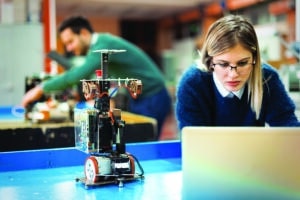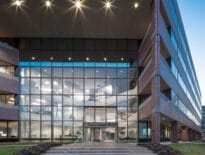
Construction of Simmons University’s new dorm and athletics tower was accelerated during the absence of students on-campus in 2020. Image courtesy of Elkus Manfredi Architects
As colleges and universities prepare for a resumption of in-person learning, so are higher education’s contributions to the construction pipeline.
Development in the institutional sector promptly took a hit in 2020 as schools shuttered campuses and switched to remote learning. Though many construction projects that were already underway were allowed to proceed, most universities slammed the brakes on planning for new large-scale projects while waiting for the pandemic to run its course.
“It was really the fear of the unknown,” said David Manfredi, CEO and founding principal of Elkus Manfredi Architects. “The universities were uncertain about the future. So, there was a slowdown. There were no cancellations of projects that had already started, but other [planned] projects were delayed until there was more certainty.”
Slowdown Predictions Prove False
Some predicted that the acceleration of remote learning during the pandemic might spell a prolonged slump in campus building projects, under the belief fewer students would want, or need, to return to campuses after they experienced the freedom of digital learning.
But a new national survey and interviews with local architecture, construction and school authorities indicate that higher-education institutions, despite the recent Delta variant surge, are starting to think once again about new construction projects – while adopting lessons learned from the pandemic.
According to the survey by the Society for College and University Planning (SCUP) and higher-ed consulting firm Brightspot, student enrollment continues to outpace many U.S. universities’ ability to accommodate their enrollees in academic and residential facilities.
Even with fresh concerns about COVID-19’s stubborn persistence, about half of schools recently surveyed are beginning to make plans for more flexible staff and faculty offices, new “active-learning” classrooms, updated lecture halls equipped with the latest digital technologies, student recreational and athletic facilities and engineering and science centers.
In other words: Colleges and universities are signaling they believe that college campuses and in-person learning are far from dead.
“It looks like some of the predictions about the effects of the pandemic are not panning out,” said Allan Donnelly, associate director at Brightspot, a Buro Happold company.
About 62 percent of the schools surveyed said they will build out more flexible or unassigned staff workspaces, while 54 percent said they will do so for academic work facilities.
BC’s New Athletic Village
One of the schools surveyed for the SCUP-Brightspot study was Boston College, which plowed ahead during the height of the pandemic with construction of its new Pete Frates Center, a baseball and softball clubhouse within its new “Harrington Athletic Village” in Brighton.
Boston College has also proceeded with construction of its new 157,000-square-foot, $155 million Schiller Institute for Integrated Science and Society that’s scheduled to open in early 2022.
Looking ahead, Daniel Bourque, vice president for facilities at Boston College, said the school is starting to analyze its options for the former Pine Manor College campus in Brookline, following last year’s takeover of the struggling liberal arts school. No decisions have been made yet on what to do with the bucolic, 50-acre property, he said.
Kenneth Fisher, a principal at architecture firm Gensler, said college work is starting to stir once again with interest in new construction. His firm is getting requests for proposals for a variety of projects, ranging from new science labs and reconfiguration of administrative and other buildings.
“There’s some pent-up demand out there,” he said. “Schools have learned a lot over the past year. They’re starting to make decisions again.”

Colleges and universities appear intensely interested in growing or improving science and engineering facilities, thanks to booms in those sectors nation-wide.
Political Pressure for Dorms
All the talk doesn’t guarantee a future campus building boom. But it does mean colleges are signaling they’re committed to on-campus learning, combined with remote-learning capabilities and options for students.
“There’s still caution out there, but if the fall semester goes well, the focus will probably switch to more long-term planning,” Fisher said.
“The higher-ed market is still a bit depressed, but things seem to be picking up a bit,” said Bryan Northrop, executive vice president and general manager at Skanska USA, the giant construction and development firm.
One encouraging sign, according to Northrop and others: an intense interest by schools in expanding and improving science and engineering facilities, reflecting the overall health of the tech and life-sciences sectors in general across the country.
Any uptick in remote learning theoretically could depress the demand for residential dormitories. And the SCUP-Brighton survey showed that dormitories are generally at the bottom of schools’ priorities lists, Brightspot’s Allan Donnelly said.
But demand for dorms was already falling before the pandemic, due to demographic trends showing a smaller pool of future U.S. students going to colleges in coming years, Donnelly and others stressed.
Still, calls for more dorm space remain a priority for municipal officials in Boston and other urban areas, as they seek to limit displacement of residents by off-campus renters, especially after the absence of tens of thousands of students from the off-campus apartment market during 2020 sent rents plummeting.
Boston College’s Bourque said his school has every intention of pursuing new dorm opportunities.
“We still think there’s a very strong demand for housing,” he said.
Pandemic Spurred New Ideas
At Simmons University in Boston, it’s full steam ahead for the school’s ambitious “One Simmons” plan, which calls for consolidation of all of its facilities onto its main campus and construction of a new “Living and Learning Center.”
Planned before the start of the pandemic, the new center will include 1,100 dorm beds and dining and athletic facilities – with construction starting next year, said Laura Brink Pisinski, vice president of university real estate development and facilities management.
Simmons never balked during the pandemic at proceeding with the multi-phase “One Simmons” project, which includes renovations of other campus buildings, projects that started last year.
“If anything, the pandemic actually helped us achieve our objectives,” she said of the accelerated work on projects when students were away last year. “We knew this consolidation was key to our future.”
Kevin Herrick, a principal at SLAM Collaborative, and others stress that many today’s campus learning and building trends actually started before the coronavirus pandemic. The COVID-19 crisis merely accelerated those trends, such as remote learning, the demand for more flexible classrooms and upgraded lecture halls with sophisticated digital technologies.
Still, some building plans are new and directly associated with the pandemic, such as proposals to build outdoor classrooms – complete with electricity, WiFi, tables, chairs and even, sometimes, tents, Herrick said.
“There doesn’t seem to be cataclysmic changes on campuses as a result of the pandemic, but we are starting to see some new ideas rolling out,” Herrick said.





